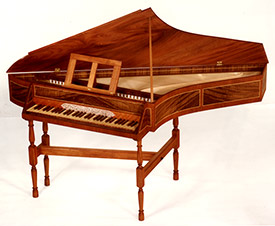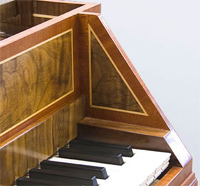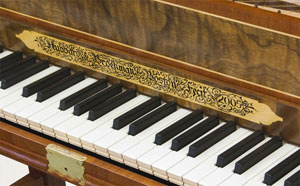After
Baker Harris (1765)
(Also available in kit form)
The
bentside spinet as a type seems to have been developed around 1630 by
a widely travelled Italian harpsichord maker, Girolamo Zenti. By the
18th century, bentside spinets were to be found everywhere in Europe
and served for all sorts of home music making and musical instruction.
No composer could have been unfamiliar with them.

The
bentside spinet is distinguished from the harpsichord in that the strings
and spine run transversely to the player and are not parallel to the
key levers. The strings are plucked much closer to their center points
than are the strings of the wing-shaped harpsichord. As a result, the
spinet produces a strong and sustained tone, but one which is darker
and less brilliant than the harpsichord. Bentside spinets almost invariably
had only one choir of strings at 8' pitch.
The
economy of space allowed by the bentside spinet makes it an ideal instrument
for musicians with limited room. The five-octave compass (FF'f''', less
FF#, 60 notes) makes it a useful study and practice instrument appropriate
to virtually the entire harpsichord literature. Its sound, rich and
sonorous, is especially suited to chamber music and the music of the
English and Italian virginalists.
Our
spinet is a copy of the 1765 Baker Harris instrument restored by Frank
Hubbard in 1975. It reproduces the Baker Harris classic decor of figured
walnut panels on the case and in the keyboard well, outlined with degamé
stringing and mahogany crossbanding. The lid, turned-leg trestle stand,
music desk, and other small parts are of solid mahogany. The finish
is French polish.
Reproductions
of original Baker Harris hardware are used on the lid and flap: brass
strap hinges for the lid, and butterfly hinges joining the keyboard
cover to the lid. A brass "S" hook, eye and doily secure the
lid to the case at the bentside.
 As
in the original, the keyboard for this instrument is made with bone-covered
naturals set off by English style mouldings at the fronts of the keys
and stained hardwood sharps. The spinet is strung in brass throughout
and designed to be pitched at a'-415 Hz. A transposing keyboard is available
as an option for those who must tune their spinets to a'-440.
As
in the original, the keyboard for this instrument is made with bone-covered
naturals set off by English style mouldings at the fronts of the keys
and stained hardwood sharps. The spinet is strung in brass throughout
and designed to be pitched at a'-415 Hz. A transposing keyboard is available
as an option for those who must tune their spinets to a'-440.
In 1986,
two earlier (1763) Baker Harris spinets came into the shop for
restoration. The work was done by Hubbard Technical Director Hendrik
Broekman. In addition to the three Harris spinets, the Hubbard shop
has
also restored an ornate and much altered anonymous English spinet, School
of Hitchcock, as well as a 1734 Josephus Mahoon spinet
English
bentside spinet after Baker Harris, 1765 – Offering
Sheet
Listen
To It...
You
can hear an excerpt from a demonstration
CD of this instrument we have prepared:
- Long
Sample - hornpipe - 1,100K 192 kpbs mp3 file (51 seconds)
- Short
Sample - hornpipe - 360K 192 kpbs mp3 file (16 seconds)
~
A Note About The Files ~
Not all mp3 files are equal! The sound of a harpsichord is particularly
difficult to compress satisfactorily. The bit rate we have chosen
for these samples is the lowest that reproduces the original recording
with negligible loss. Download times will vary widely depending
on your setup and the quality of your connection. On a 28K
Internet connection, the shorter sound sample may take from about
5 to over 10 minutes to download. If you have a fast connection (T1,
cable modem, DSL) please try the long sample - you may expect download
times substantially under a minute.
~
Problems Playing the File ~
If you cannot play the file through your web browser, PC users
with the Microsoft browser can right click on the link, then choose
the "Save target" option to download the file, then use
an MP3 player (or a the Windows media player) to listen to it.
We
now have available a demonstration CD
of this instrument ($10.00 ppd. in U.S.). Please - inquire via our
contact form.

